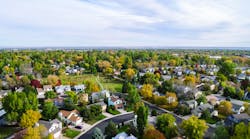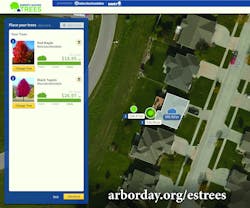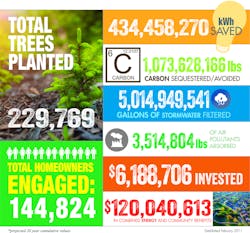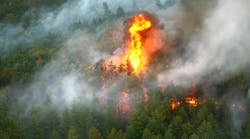Across the country, utility companies are in search of solutions and strategies to reduce peak demand, improve customer and community relations, and incorporate responsibility and sustainability into their image. More and more, these organizations are turning to trees as a compelling answer for all three of these challenges.
Given how many improperly planted trees utilities and municipalities must either severely prune or remove every year, tree planting may not initially seem like the best idea. However, that is a primary reason why it’s great to see this movement spanning the country. By distributing trees, at no cost to customers, utilities have the ability to help guide what type of trees are planted and where they are strategically going in the ground.
The Arbor Day Foundation is excited about this progress. The organization is encouraging trees as a solution to the issues facing utilities and has developed a program — Energy-Saving Trees — to help utility companies and similar organizations provide trees for their customers that will lower energy usage and create a sense of good will.
Reducing Energy Usage
Planting a 3-ft to 5-ft tree may not provide immediate results but the long-term benefits are impressive. When planted in the right place, a fully grown tree can reduce energy usage by up to 20%. This is the kind of impact that can help levelize a utility’s demand curve and reduce extreme peak usage, thereby, positively affecting a utility’s bottom line.
The benefits, however, are directly tied to planting the right tree in the right place. Many people are often unsure of how and where to plant trees. They may not understand that deciduous trees planted along the sunnier sides of a home can provide cooling shade in the summer and let the sunshine through their bare branches to heat a home in the winter. They may need guidance on how evergreen trees planted on the north and northwest sides of a home can help to block cold winter winds and potentially reduce heating bills.
Because of this, the Arbor Day Foundation has built a research-based online mapping tool for its Energy-Saving Trees program that can help utility customers find the best location on their property for their trees. This tool was developed by the U.S. Forest Service, the Davey Institute and the Arbor Day Foundation. It is powered by i-Tree technology, which is credible scientific research that takes the guesswork out of tree planting by helping the homeowner to identify the ideal planting location for energy savings. By entering a home address, an individual can plot a specific species of tree within a satellite image of his or her yard and actually see an estimated dollar amount of energy savings that will result from the tree in that strategic location.
Importantly, the environmental benefits of tree planting don’t end in reduction of kilowatt-hours and therms. They also filter our air, clean our water and help to slow climate change. That’s why, in addition to measuring energy savings, this tool also can calculate additional benefits over time, including estimated tons of carbon sequestered, air pollution absorbed and gallons of stormwater intercepted. It considers the overall impact of the tree over the course of the next 20 years.
Building Community Connections, Strengthening a Brand
Often, utilities face criticism for rate increases, power outages and tree removal due to power line interference. Media outlets do not usually have a positive message to deliver to the public regarding these business challenges, so awareness is formed from negative news and bills in the mail.
Trees offer an opportunity to improve a utility’s image with not only the customers it serves but also the community as a whole. The situation where a utility is looking out for the best interests of its community, by expanding the urban tree canopy with power lines in mind, is a great story to tell. Providing trees to customers at no charge in an effort to lower their energy bills sends an important and uplifting message. And being able to report on the measured long-term environmental benefits of those trees through a tool like i-Tree is a powerful public relations tactic. All in all, trees help to shine a positive light on the important work utilities are doing every day.
Imagine how quickly the public’s perception can change if the story of a utility removing or heavily pruning trees near power lines concluded with the utility providing trees to the affected homeowners, complete with guidance on where to plant them to not only avoid utility lines but also lower their energy bills over time. The connection it can create with customers is tangible.
Real-World Implementation
While the theory behind all of this may sound good, how well do trees work as a tool to reduce peak demand, improve customer and community relations, and build an image of responsibility and sustainability? Based on what the Arbor Day Foundation is seeing with its Energy-Saving Trees utility partners nationwide, they work quite well.
Through the Arbor Day Foundation’s efforts with Energy-Saving Trees utility partners dating back as far as 2011, nearly 230,000 trees have been distributed to the homeowners served — either through community pick-up events, delivery service to their door, or a combination of the two. The trees offered by the Arbor Day Foundation’s partners are projected to result in a 20-year savings of more than 430 million kWh as well as an average return of $19 in total community and environmental benefits for every dollar invested by the utility.
This impact is not concentrated in one specific region. The Arbor Day Foundation’s utility partners serve customers in nearly 40 states, canvasing the country. Trees are being planted in all possible hardiness zones in the United States, and the selection of tree species offered is determined by the region they will be planted in as well as the preferences of the partner.
For the Exelon Corp., providing electric and gas service for areas throughout the Northeast, their Energy-Saving Trees results over the last seven years are impressive:
• Six different electric company partners: Atlantic City Electric, BGE, ComEd, Delmarva Power, PECO and Pepco
• 85,948 trees distributed to customers
• 50,884 homeowners engaged
• $26,623,671 in projected energy savings for customers
• $28,723,411 in projected air, water and carbon benefits for the communities served.
Exelon is proud to have provided more than $55 million in total benefits over the next 20 years by engaging customers and helping them plant trees. It’s just one more way the company is serving its customers.
"Pepco participates in the Energy-Saving Trees program because it is the right thing to do for our customers and our communities," said Dave Velazquez, president and CEO of Pepco Holdings. "Planting more trees, one home at a time, will help conserve energy, lower utility bills, beautify our neighborhoods and protect our environment. Delivering free trees in our service territory is a simple smart and straightforward way to better serve families across our regions."
Newer to the tree planting movement is Duke Energy in Florida. With a focus on "building a smarter energy future," the organization was drawn to trees as it looks to improve the grid, support energy conservation and build upon Duke’s image as a good environmental steward.
"At Duke Energy, we love trees and know our customers do too," said Nick Esposito, senior vegetation management specialist for Duke Energy Florida. "Our partnership with the Arbor Day Foundation has provided a great way to give back to our customers while informing them of the benefits of trees, where to plant them to maximize those benefits and how to prevent conflicts with overhead power lines."
Duke’s tree planting efforts through the Arbor Day Foundation’s Energy-Saving Trees program began in spring 2017 when 2,200 trees were distributed to homeowners. Those trees have the power to reduce energy usage by more than 2.2 million kWh, sequester more than 5.3 million pounds of carbon and filter nearly 23 million gallons of stormwater over the next 20 years. Because of the popularity of the program, Duke continued its efforts in 2018. Customers had the opportunity to reserve trees through the online tool before distribution began, and all available trees were reserved within just five days.
These are just two of the many success stories the Arbor Day Foundation has helped to foster around the country. Utility representatives are reporting positive outcomes not only from an environmental standpoint, but also from a customer and employee engagement perspective.
Get Planting
Whether a utility chooses an automated, turnkey tree distribution solution like the Arbor Day Foundation’s Energy-Saving Trees program or works with a local nursery or tree planting organization to plant in local public spaces, the trees placed in the ground today will benefit the organization’s customers, brand and community for years to come. ♦
Kristen Bousquet is the program development manager for the Arbor Day Foundation’s Energy-Saving Trees program. She joined the Arbor Day Foundation team in 2014




